As the project neared completion I had to rethink
the name – “Troutboat” does not
have the cache to match my feelings about this project.
The more I thought the more “Hawbuck”
kept coming back to the top of a short list. The name
should reflect the character – and by golly
nothing reflected that better than Hawbuck! In case
you are wondering, I found the name on the net a few
years ago while searching “old” words
for something new. I found two sources for Hawbuck
(or haw-buck) – one from New Zealand –
meaning a clown or court jester, the other from USA,
meaning a muleskinner (mule driver) – both uses
are well outdated and very unlikely to be heard in
either country.
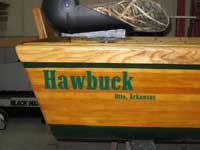 |
As the project
neared completion I had to rethink the name
– “Troutboat” does not have
the cache to match my feelings about this project. |
This boat was a funny thing with roots deep in the
Ozarks. It was indeed the “Hawbuck” –
so I ordered decals and vowed not to give it another
thought. While I was at it I ordered “Miss Jenny”
for the transom – trust me – putting your
wife’s name on your boat is never a bad idea
– it’s the thought that really counts!
.
This may be a recap, but the majority of the wood
is cypress. I went to a sawmill near Batesville, AR
and bought 5/4 cypress for $1.00 a board foot –
well below the specialty wood store prices. The gunnels
are ash, seat thwarts oak, painted bulkheads birch
plywood, stained bulkheads oak plywood.
| The gunnels are
ash, seat thwarts oak, painted bulkheads birch
plywood, stained bulkheads oak plywood. |
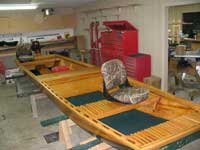
|
I found MinWax pecan stain to be a complementary
color, adding to the natural richness of cypress,
and covered it with several coats of satin finish
spar varnish – the latter coats applied with
a cotton cloth dipped in the varnish. It takes a couple
of hours to varnish the whole thing with a paint brush
– about 30 minutes with the cloth! There is
a lot of wood to varnish on the Hawbuck – but
I was still surprised when I had to go back to the
store for more varnish!
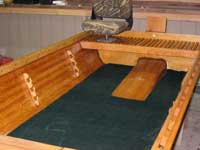 |
I like carpet
in a boat – it is fun for your toes and
it makes the hull quieter so you can sneak up
on fish. |
I like carpet in a boat – it is fun for your
toes and it makes the hull quieter so you can sneak
up on fish. I ordered ten feet of six feet wide (hunter
green) bassboat carpet and split it right down the
middle and glued it in the bottom of the hull. It
looks inviting and is a real pleasure to walk on.
The seats are Tempress seats from BassPro Shops –
they run $100 each, which is a lot, but they so very
comfortable the extra $$ was well spent.
| Here is the boat’s
namesake Miss Jenny expertly trying out the front
seat for size. |
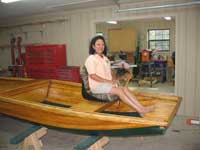
|
The bench tops and front deck is made of ½’x1”
cypress strips. A good use for the two knotty boards
I had left. Here is the boat’s namesake Miss
Jenny expertly trying out the front seat for size.
The front seat may appear six inches too far forward
– but actually it is there for a reason. The
entire bow section is beefed up to act as a transom
trolling motor mount – should I decide to use
the boat for some backwater crappie or bass fishing.
By placing the seat forward you can easily reach the
trolling motor tiller handle. I have been known to
sneak up on momma bass in these riverboats!
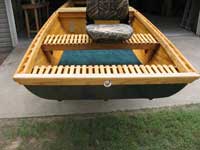 |
The front seat
may appear six inches too far forward –
but actually it is there for a reason. |
The last major task was fitting the giant stainless
piano hinge that would hold the two hulls together.
Fearing misalignment – I measured and made minute
adjustments over and over for a ridiculous amount
of time – and then finally said to heck with
it and installed 64 - 2” stainless screws into
the two hinge halves. Happily, the result was two
properly aligned hulls!
| The last major task
was fitting the giant stainless piano hinge that
would hold the two hulls together. |
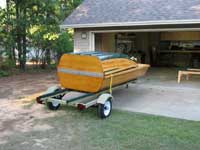
|
On the LongJon
I placed the hinge flat on top of the decks. It must
have annoyed people because nearly every single person
made a comment about the hinge. So this time I placed
the hinge where only the edge would show when the
boat was open. LongJon also had double bulkeads with
2”x 4”s in the middle on each side of
the fold – I figured it was way overbuilt –
so this time the bulkheads are one thickness of ¾”
oak plywood – a risk maybe – but I think
it will be plenty strong for protected waters. There
are four 3”x 6” x 3/16” metal plates
and two 5/8” stainless bolts to hold the hulls
in the open position – just like I used with
LonJon. With the bolts snugged down there was no hull
movement between the hulls with the prototype –
so I feel confident that two bolts are enough. I could
not find stainless plate for a reasonable cost, so
I used mild steel and painted them. Inside each bolt
hole is a glued in copper tube – I learned on
LongJon the wood holes swell making it hard to align
the bolts.
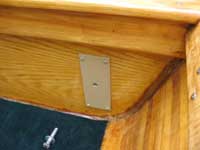 |
The bulkheads
are one thickness of ¾” oak plywood
– a risk maybe – but I think it
will be plenty strong for protected waters. |
Leak Tests!
The “Official Launch” will be at the
Russellville messabout. But to me it is not reasonable
to design and build a boat and then put it in the
water the first time and expect everything to be ship
shape. I nearly always forget something – mostly
minor stuff – but hey, I am not by any means
an engineer! What if the thing promptly folds up and
sinks!!
| It is not reasonable
to design and build a boat and then put it in
the water the first time and expect everything
to be ship shape. |
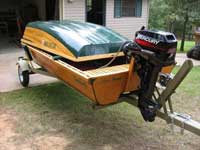
|
So one week before the messabout Jenny and I headed
to the Arkansas River for leak and safety tests –
not to mention it had been a full year since I ran
the 9.9hp Mercury. Wouldn’t you know- it rained!
Oh! There is nothing more pitiful than to be waiting
on the rain to launch a brand new boat! I check everything
three times – paced, checked the weather channel,
checked everything, paced – and generally got
on Jenny’s nerves all morning!
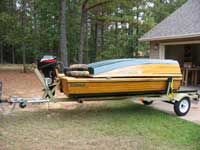 |
There is nothing
more pitiful than to be waiting on the rain
to launch a brand new boat! |
Finally a break came in the weather and I quickly
hooked up the trailer. Hawbuck sits on the trailer
backwards – strange but very functional. This
allows me to tow on a slightly modified trailer in
the open or closed position. An interesting point
about LongJon was the trailer collapsed – cool
but a pain in the butt if you need to launch or recover
in foul weather. Plus I had to remove the motor for
transport – awe my aching back!
| Hawbuck sits on
the trailer backwards – strange but very
functional. This allows me to tow on a slightly
modified trailer in the open or closed position. |
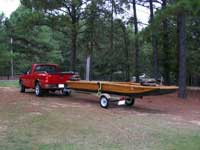
|
So, Hawbuck sets on the trailer backward –
motor always installed (it is bolted on). There is
plenty of trailer bunk under the front section of
the hull in the open position – allowing easy
towing and fast launching.
Even though it was cloudy – the colors really
came out once the boat was out of the shop! I know
I should be modest and not be too fond of my own work
– but I just love the wood tones and hunter
green! It somehow makes me relax just looking at it.
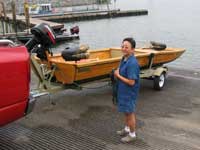 |
Jenny expertly
manned the ropes and I eased down the ramp –
secretly hoping she would float before water
came over the bows. |
We quickly drove 30 miles to the river – and
before I could fully comprehend that months of planning
and work and all the stuff that goes into boat making
was about to come together we were setting on the
boat ramp! This time I did remember one last photo!
Jenny expertly manned the ropes and I eased down
the ramp – secretly hoping she would float before
water came over the bows. My concern was wasted –
this boat is very light and she came up very easy
– not even close to taking on water. I also
remembered to disconnect the tiedowns, raise the motor,
AND install the drain plug!
| This ‘99 Mercury
has the water pick-up beneath the cavitation plate
– you either have to run it in a bucket
or buy an expensive adaptor. |

|
Lots of outboards have the water pickup down on
the skeg. You can run them at home with “rabbit
ears” and a water hose. This ‘99 Mercury
has the water pick-up beneath the cavitation plate
– you either have to run it in a bucket or buy
an expensive adaptor. So after all the boat hoopla
– I did not even know if the thing would start.
I recalled I did run the carb dry the last outing
– about thirteen months ago… Wouldn’t
you know she started with the first pull and idled
right down to a soft purr. Whew!
 |
Wouldn’t
you know she started with the first pull and
idled right down to a soft purr. Whew! |
A few minutes later and we were boating! Jenny took
her seat up front and I walked up and down the full
length of the bottom. Not as stable as a 48”
wide Jon boat – but the Hawbuck is very comfortable
to walk around. I put one foot on the gunnels and
pressed down – she remained level. The floor
was just a little springy – there is only 3/8”
of wood on the bottom (before sanding) and even with
the strakes she gives a little when you walk, especially
around the back section. I forgot, but you could “feel
the water” with the plywood LongJon as well.
I supposed it is common with large single layer bottoms.
| A few minutes later
and we were boating! |

|
Of course there were no leaks, not with two layers
of 12oz glass on the outside and one on the inside.
I assumed my position and soon we were underway. Thank
goodness the motor did not cavitate! I literally guessed
about the tunnel height and width and proper motor
position. Too high and the prop will slip –
to low and you wasted a lot of hours building a tunnel.
Frankly, I don’t know if it could be better!
Let’s just say you do not notice the boat has
a tunnel – much less one that is offset a few
inches.
 |
I tried various
emergency maneuvers – hard turns, full
stop from wide open – jerky stuff you
would do to avoid a collision. My feet stayed
dry and Jenny did not complain. |
We went through a variety of stops, starts, turns,
poking along, and wide open, everything you would
do operating a boat. I tried various emergency maneuvers
– hard turns, full stop from wide open –
jerky stuff you would do to avoid a collision. My
feet stayed dry and Jenny did not complain. I did
notice the engine did not seem to run fast enough
– then it dawned on me this was a 9.9 it runs
1000 rpm less than the 15hp motors I am accustomed
to. I am using this motor because one of the rivers
I want to visit has a 9.9 hp restriction. I guess
it runs about 15 mph – maybe someone at the
messabout will have a GPS and we will know for sure.
| Here is the trailer
– notice the bunks are angled to the right
so the motor clears the winch. |
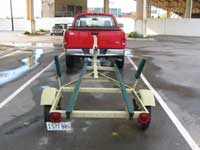
|
Anyway, Hawbuck has my stamp of approval. It is pretty,
but it really is just a lowly fishing boat and will
be used as such. In fact my bother and I will make
a 75 mile camping/fishing
trip in her – in a couple of weeks.
Notes: Here is the trailer – notice the bunks
are angled to the right so the motor clears the winch.
You have to tilt the motor up to trailer the boat.
The only modification was the addition of longer bunks
and the two metal supports up front.
This boat was built the old tyme “seat of the
pants” way – simply put - my best guess.
I am not by any means a qualified (or even novice)
marine engineer so am oblivious if there are significant
safety issues inherent in the design. I did not include
design drawings, a bunch of numbers, etc, simply because
the only drawings were a couple of sketches on the
top of the work bench and are probably already under
stains and whatnot. In fact as I sit here I already
don’t recall much more than she is 18’
long and 54” at the beam (more or less). However,
if someone wants to draw this up I will measure stuff
for you – I only ask that you provide the “plans”
free of charge to our fellow Duckworks readers.
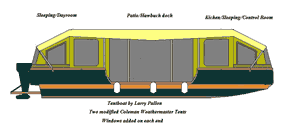 Click images for larger
views
Click images for larger
views |
You might want to know why Hawbuck folds.
The answer is so it can be transported to and from
the water on Tentboat’s deck. Look for 32’
Tentboat sometime in 2007!

Articles by Larry Pullon
|